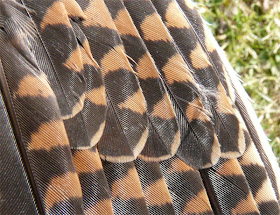In December 2011 the British Trust for Ornithology (BTO) launched their abnormal plumage survey, http://www.bto.org/volunteer-surveys/gbw/about/background/projects/plumage where they asked volunteers taking part in their Garden Birdwatch Survey to record birds with abnormal plumage. The aim was to see which species were affected most frequently, in what way and where they were most frequently recorded. I have been keeping an eye on this survey which has thrown up some pretty amazing looking birds, in particular the European Robin with a white breast and the stunning Blue Tit with a black head, and so I thought I would show off some of the usual birds I have seen in the last couple of years. Some of these images I have posted before, so apologies if you haven seen them, but I thought it would be good to have them all together in one post.
I thought I would start with the most striking, and this amazing Blackcap which was Captured on September 2010 at Titchfield Haven. As you can see the all of the primary, primary coverts, secondary, and tertial feathers are virtually pure white, whereas the tail feathers are darker on the shaft and towards the upper tail and there are a couple of white feathers in the crown.
 |
| Blackcap 18th September 2010 - Titchfield Haven |
An amazing looking bird....
 |
| Blackcap 18th Septemebr 2010 - Titchfield Haven |
The wing below is also that of a Blackcap which was again captured at Titchfield Haven, but on 22nd October 2011. This bird has three almost white primary coverts, and a white leading edge to some of the primaries,
 |
| Blackcap 22nd October 2011 - Titchfield Haven |
This flock of Greylag Geese were seen up near Aldermaston in December 2011. In all there were 74 birds present but three of them were leucistic, with all of the coloured plumage washed out, whereas the undertail was still pure white as expected.
 |
| Greylag Geese, December 2011 - Aldermaston |
Regular readers to this blog will have seen this Great Tit, which I caught in my garden on 28th October 2011. As you can see, this bird had an almost white tail, but overall the plumage was very washed out, with paler patches on the mantle and crown.
 |
| Great Tit, 28th October 2011 - Fareham |
A finally this Grasshopper Warbler, which was captured on 14th July 2011 at Titchfield Haven.
 |
| Grasshopper Warbler, 14th July 2011 - Titchfield Haven |
 |
| Grasshopper Warbler, 14th July 2011 - Titchfield Haven |
All in all quite an interesting collection, with some of them being species that you would not normally encounter in a garden.

































.jpg)
.jpg)









